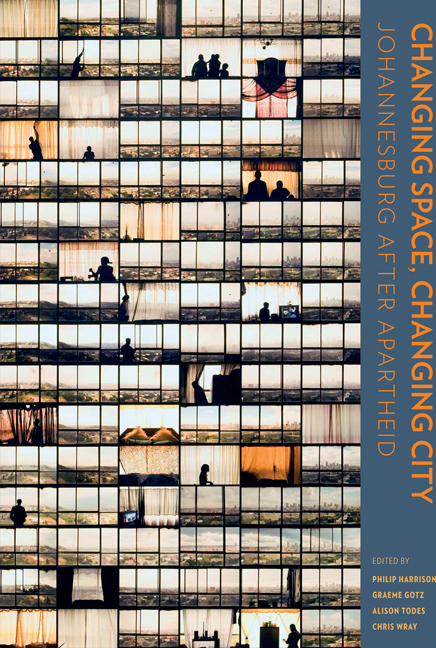Book contents
- Frontmatter
- Contents
- Preface
- Cartography
- 1 Materialities, subjectivities and spatial transformation in Johannesburg
- Section A The macro trends
- Section B Area-based transformations
- 12 Between fixity and flux: Grappling with transience and permanence in the inner city
- 13 Are Johannesburg's peri-central neighbourhoods irremediably ‘fluid’? Local leadership and community building in Yeoville and Bertrams
- 14 The wrong side of the mining belt? Spatial transformations and identities in Johannesburg's southern suburbs
- 15 Soweto: A study in socio-spatial differentiation
- 16 Kliptown: Resilience and despair in the face of a hundred years of planning
- 17 Alexandra
- 18 Sandton Central, 1969–2013: From open veld to new CBD?
- 19 In the forest of transformation: Johannesburg's northern suburbs
- 20 The north-western edge
- 21 The 2010 World Cup and its legacy in the Ellis Park Precinct: Perceptions of local residents
- 22 Transformation through transportation: Some early impacts of Bus Rapid Transit in Orlando, Soweto
- Section C Spatial identities
- Contributors
- Photographic credits
- Acronyms
- List of plates
- List of figures
- List of tables
- Index
13 - Are Johannesburg's peri-central neighbourhoods irremediably ‘fluid’? Local leadership and community building in Yeoville and Bertrams
from Section B - Area-based transformations
Published online by Cambridge University Press: 20 April 2018
- Frontmatter
- Contents
- Preface
- Cartography
- 1 Materialities, subjectivities and spatial transformation in Johannesburg
- Section A The macro trends
- Section B Area-based transformations
- 12 Between fixity and flux: Grappling with transience and permanence in the inner city
- 13 Are Johannesburg's peri-central neighbourhoods irremediably ‘fluid’? Local leadership and community building in Yeoville and Bertrams
- 14 The wrong side of the mining belt? Spatial transformations and identities in Johannesburg's southern suburbs
- 15 Soweto: A study in socio-spatial differentiation
- 16 Kliptown: Resilience and despair in the face of a hundred years of planning
- 17 Alexandra
- 18 Sandton Central, 1969–2013: From open veld to new CBD?
- 19 In the forest of transformation: Johannesburg's northern suburbs
- 20 The north-western edge
- 21 The 2010 World Cup and its legacy in the Ellis Park Precinct: Perceptions of local residents
- 22 Transformation through transportation: Some early impacts of Bus Rapid Transit in Orlando, Soweto
- Section C Spatial identities
- Contributors
- Photographic credits
- Acronyms
- List of plates
- List of figures
- List of tables
- Index
Summary
Johannesburg's inner city is a convenient symbol in contemporary city culture for urban chaos, unpredictability, endless mobility and undecipherable change – as emblematised by portrayals of the infamous Hillbrow in novels and movies (Welcome to our Hillbrow, Room 207, Zoo City, Jerusalema) and in academic literature (Morris 1999; Simone 2004). Inner-city neighbourhoods in the CBD and on its immediate fringe (or ‘peri-central’ areas) currently operate as ports of entry into South Africa's economic capital, for both national and international migrants. These neighbourhoods are characterised by a degree of urban decay that has earned them labels such as ‘slums’ and ‘sinkholes’, and perceptions of being in need of ‘urban management’ and the reaffirmation of ‘law and order’. Some of these areas have attracted specific attempts at urban regeneration led mostly by the municipality, followed or not by private investment. They are all marked by a level of informality in housing and in economic activities, which is oft en a condition for low-income migrants to enter the urban labour and housing markets. This port-of-entry function has consequences in terms of urban management and governance.
Looking beyond extreme visions of chaos and ‘no-go zones’ for the state, which are certainly not true of contemporary Johannesburg, scholars have highlighted the difficulties of community participation and local governance. Abdumaliq Simone, in a piece entitled ‘People as Infrastructure’ (2004), implies that it is only the people who can be relied upon to build the city. However, he simultaneously highlights the fluidity of their social networks and belongings, their impermanence, multiplicity and contradictions – which render the usual community participatory formula ineffective as no resident can be placed into a single category or identity group. Lipietz (2004, 2008), adopting the perspective of a well-intentioned municipal council, shows the conundrum in which such authorities are caught, and the often insurmountable obstacles for local government when it comes to implementing the progressive and participatory aspects of inner-city policies. Dinath (2013) mentions the inappropriateness of municipal institutions for dealing with the dynamics of fluidity and transience that have characterised Johannesburg's inner city since its creation.
Several other case studies on inner-city neighbourhoods (Bénit-Gbaffou 2008; Harrison 2002; Katsaura 2012; Matjomane and Bénit-Gbaffou forthcoming; Molefe 2007) reveal the challenges of community participation in urban governance from a civil-society perspective, be it around housing, public space or the management of informal trading.
- Type
- Chapter
- Information
- Changing Space, Changing CityJohannesburg after apartheid, pp. 252 - 268Publisher: Wits University PressPrint publication year: 2014



